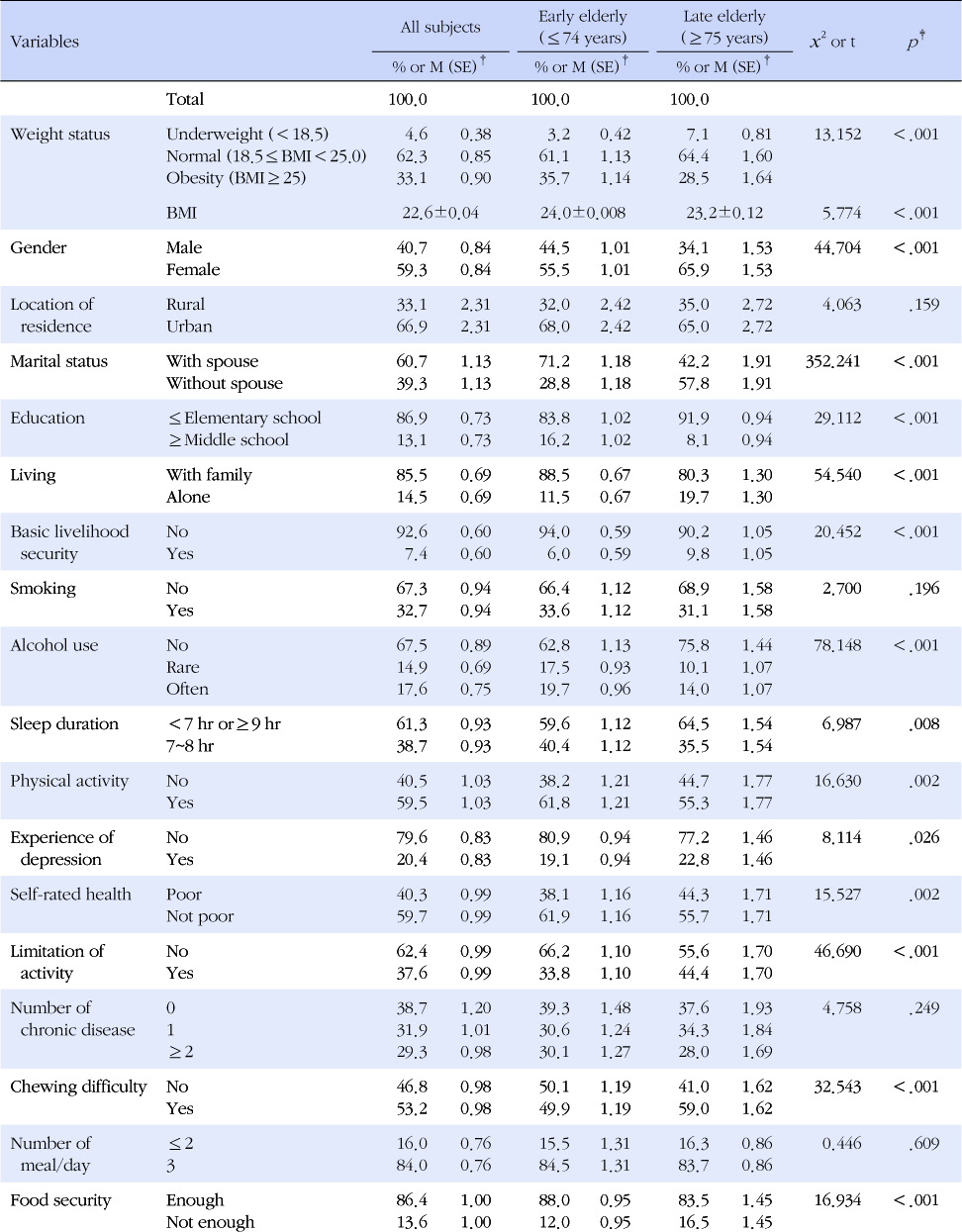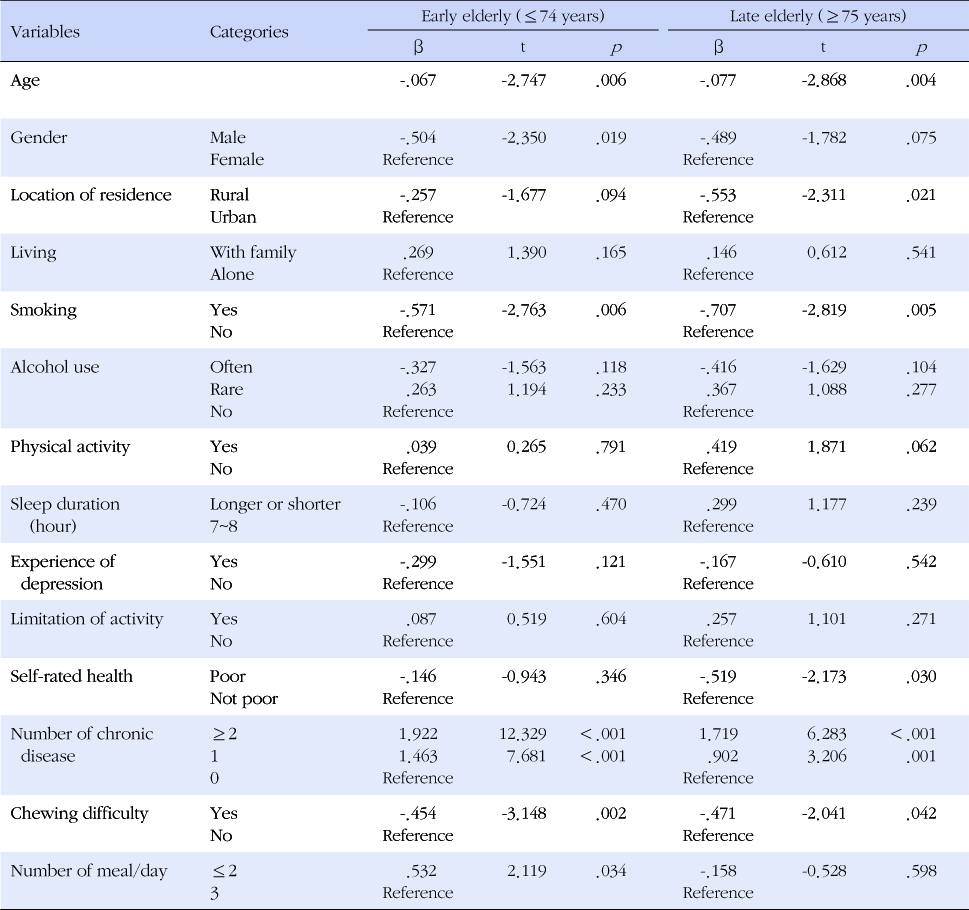References
1. Bae NK, Kwon I, Cho YC. Ten year change of body mass index in Korean: 1997-2007. Korean J Obes 2009. 18(1)24–30.
2. Berraho M, Nejjari C, Raherison C, ElAchhab Y, Tachfouti N, Serhier Z, et al. Body mass index, disability, and 13-year mortality in older French adults. J Aging Health 2010. 22(1)68–83.
3. Chae KH, Won CW, Choi H, Kim BS. Obesity indices and obesity-related quality of life in adults 65 years and older. Korean J Fam Med 2010. 31(7)540–546.
4. Cho YH. A study on the related factors and status of body mass index in rural elderly. J Korean Gerontol Soc 2007. 27(4)897–912.
5. Choi H. Evaluation of health status and dietary intakes of the elderly in the rural area by dental health status 2009. Yongin: Dankook University; Unpublished master's thesis.
6. Choi JH, Kim MH, Cho MS, Lee HS, Kim WY. The nutritional status and dietary pattern by BMI in Korean elderly. Korean J Nutr 2002. 35(4)480–488.
7. Donini LM, Savina C, Cannella C. Eating habits and appetite control in the elderly: The anorexia of aging. Int Psychogeriatr 2003. 15(1)73–87.
8. Ferra A, Bibiloni DM, Zapata ME, Pich J, Pons A, Tur JA. Body mass index, life-style, and health status in free living elderly people in menorca island. J Nutr Health Aging 2012. 16(4)298–305.
9. Hickson M. Malnutrition and ageing. Postgrad Med J 2006. 82(963)2–8.
10. Kim JS, Kim YH, Yu JO. Factors contributing to low weight in community-dwelling older adults. J Korean Acad Community Health Nurs 2011. 22(4)429–437.
11. Kim NS, Moon OR, Kang JH, Lee SY, Jeong BG, Lee SJ, et al. Increasing prevalence of obesity related disease for Koreans associated with overweight and obesity. Korean J Prev Med 2001. 34(4)309–315.
12. Korea Centers for Disease Control and Prevention. The Fourth Korea National Health and Nutrition Examination Survey [KNHANES IV-3] 2010. Retrieved June 22, 2011. from
http://knhanes.cdc.go.kr/.
13. Korean National Statistical Office. Census of elderly population in Korean 2011 year 2011. Seoul: Author;
14. Krall EA, Hayes C, Garcia R. How dentition status and masticatory function affect nutrient intake. J Am Dent Assoc 1998. 129(9)1261–1269.
15. Lee MS. Nutritional risk, perceived health status, and depression of the young-old and the old-old in low-income elderly women. J Agric Med Community Health 2012. 37(1)12–22.
16. Lee IS, Ko Y, Lee KO. Evaluation of the effects of a frailty preventing multi-factorial program concentrated on local communities for high-risk younger and older elderly people. J Korean Acad Community Health Nurs 2012. 23(2)201–211.
17. Lee JH. Effect of body weight on mental health in the elderly. J Korean Geriatr Psychiatry 2004. 8(2)102–106.
18. Lee KS, Hwang IC, Kim SS, Kim KK. Perception of obesity and its related factors. Korean J Obes 2009. 18(3)116–122.
19. Lee S, Jeon S, Lee J. Factors related with low body weight in older adults at a urban-rural composite area. J Korean Gerontol Soc 2008. 28(1)105–121.
20. Oh Y, Bae W, Kim O. A study on physical and mental function affecting self-perceived health of older persons in Korea. J Korean Gerontol Soc 2006. 26(3)461–476.
21. Ritchie CS, Joshipura K, Silliman RA, Miller B. Oral health problems and significant weight loss among community-dwelling older adults. J Gerontol A Biol Sci Med Sci 2000. 55(7)M366–M371.
22. Statistics Korea. 2010 elderly statistics 2010. Retrieved Oct. 28, 2011. from
http://kostat.go.kr.
23. Statistics Korea. 2011 elderly statistics 2011. Retrieved Feb. 20, 2013. from
http://kostat.go.kr.
24. Woo J, Leung J, Kwok T. BMI, body composition, and physical functioning in older adults. Obesity 2007. 15(7)1886–1894.
25. Yan LL, Daviglus ML, Liu K, Pirzada A, Garside DB, Schiffer L, et al. BMI and health-related quality of life in adults 65 years and older. Obes Res 2004. 12(1)69–76.
26. Yeom J, Kim JK, Crimmins EM. Factors associated with body mass index (BMI) among older adults: A comparison study of the U.S., Japan, and Korea. J Korean Gerontol Soc 2009. 29(4)1477–1498.
27. Yim KS, Lee TY. Sociodemographic factors associated with nutrients intake of elderly in Korea. Korean J Nutr 2004. 37(3)210–222.
28. Yoo J, Yoo K. The influence of smoking and smoking cessation on body weight and exercise abilities. J Coaching Dev 2006. 8(4)185–194.



